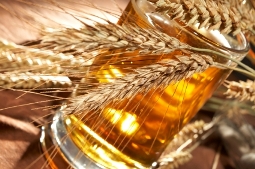Have you ever had a problem with finely crushed malt creating a stuck sparge when home brewing? This week we look at how wet and conditioned milling can help reduce the chance of a stuck sparge by creating a more porus grain bed.
Why Wet Mill?
 I knew little about wet milling or its variants until a recent article (Mar-Apr 2010, BYO Magazine) highlighted the technique. While rarely used in the US, this technique attempts to raise the moisture content of the grain by 20-30% using steam or a hot spray of water.
I knew little about wet milling or its variants until a recent article (Mar-Apr 2010, BYO Magazine) highlighted the technique. While rarely used in the US, this technique attempts to raise the moisture content of the grain by 20-30% using steam or a hot spray of water.
The wet grain is then run through your malt mill at a narrower than usual gap to split the interior from the grain husk. Done properly, you will get larger segments of intact grain husk. The advantage is a more porus grain bed without the dusty grain particles produced by dry milling. This can make a stuck sparge less likely.
Conditioned Milling
I do not recommend trying this unless you have a two roller grain mill such as the Barley Crusher, as other types of grain mills could get gummed up by the wet grains. Even then, one must be careful not to overexpose the grains, as grains that are two wet will gum up the mill.
Pure wet milling is difficult to duplicate in a home environment, but two practical conditioned milling options exist for the homebrewer. One is to use a short exposure to steam, while the second method requires spraying with hot water for a short period of time.
The steam options requires a large pot of boiling water and a false bottom. Put the grains in a large grain bag and set it aside. Then bring the pot to a boil. Once you had a strong boil going, place the bag over the steam rising from it for about a minute and a half. Then pulled the bag out, stir it a bit and quickly mill it.
A second option, described in the BYO article, involves sprinkling hot water at 158F over the grains. Here it is best to treat a smaller amount of grain at a time over a lauter tun or false bottom, so the spray can reach all of the grains. Heat water to 158F and put it in a spray bottle or watering can, and lightly spray the grains for 60 seconds, allowing excess water to drop off. Allow the malt to sit for a minute or two to absorb as much water as possible and then mill it. Reportedly this technique results in a slightly higher water content than steaming.
The milling itself should be straightforward, but start as quickly as possible. Set the malt mill at a slightly narrower gap than normal, and proceed to mill. If the mill starts to get gummed up with wet grain, then stop as you have probably gone too far with the water. You want the husks to come out slightly wet and intact, but the inside of the grains to be largely dry. If too wet, let the grains dry for a a bit before proceeding.
If you compare some dry milled malt to the conditioned malt you should see a marked difference particularly in the larger pieces of husk and reduced amount of grain dust. I will note that this is not a technique you should need for every batch. A properly set malt mill should produce a great dry mill crush and normal sparge for most beers. However, if you are brewing a beer with a lot of sticky adjuncts such as wheats, unmalted barley, etc, you may want to consider giving this a try.
Run some dry malt through your mill at the end to help clean up any mess you have left, and then dry the entire mill. Its best not to leave gobs of wet malt sitting on your steel rollers.
Thanks for joining us on the BeerSmith Home Brewing Blog. If you don’t have a high quality malt mill you may want to check out the Barley Crusher, and don’t hesitate to subscribe to our newsletter for regular delivery of our best articles.
Pingback: BeerSmith: Conditioned and Wet Grain Milling for Beer | Its Beer-o-clock
Food for thought certainly, I will just have to invest in some new equipment before I give it a whirl!
I condition my malts all the time, however I use another method successfully.
I measure approximately 2% water by weight of the whole grainbill (5 kilo’s will result in 100ml), spray the malts with the cold water and mix them thoroughly.
The husk of the grains will absorb the water and be leather-like to the touch.
I have not had any problems with the rollers getting sticky or needing a dry mill to dry them off.
Thanks for the tip – your method does sound a bit simpler so I will give it a try.